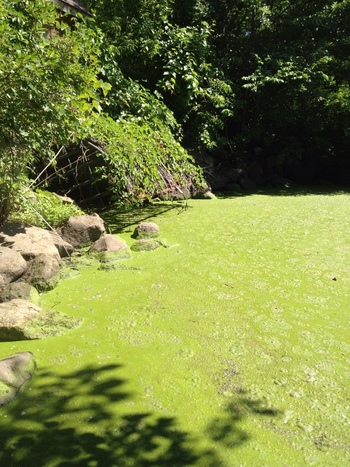Storm water treatment will strip phosphorus from Arboretum pond
Storm water engineers will try to keep Lake Wingra’s wetlands from being assaulted by phosphorus and sediment by adding alum to a pond in the UW Arboretum.
The UW Arboretum’s Marion Dunn Pond will soon be home to a pilot project aimed at snatching the phosphorus and sediment from storm water before it surges into the wetlands around Lake Wingra.
For at least the next year, a system installed temporarily by Madison municipal storm water engineers will add alum — the common name for potassium aluminum sulfate — to storm water running from the adjacent Nakoma and Westmorland neighborhoods into the small pond on the Arboretum’s northern border.
“The alum will bind to the solids and phosphorus in the storm water, and it will all sink to the bottom of the pond,” says Brad Herrick, Arboretum ecologist and research program manager. “That will act to clarify the water column in the pond itself, and improve the quality of water flowing into Arboretum wetlands and Lake Wingra.”
Large doses of phosphorus (largely from eroded soils, farm fertilizers and animal waste) are a major concern for Wisconsin’s rivers and lakes. Phosphorous fuels unrestricted growth of algae and bacteria, throwing a natural system out of balance and depriving other organisms of nutrients and oxygen.

Algae-covered Marion Dunn Pond on Madison’s west side catches contaminants like phosphorus before they reach the lake.
In an effort to reduce the amount of phosphorus gathering in wetlands, streams and lakes, municipalities and large landowners like UW–Madison have permits restricting the amount of phosphorus and sediment that runs off streets and parking lots and other surfaces and into waters flowing to the Rock River.
“The city of Madison has been looking at innovative ways to reduce the amount of phosphorus entering the Lake Wingra system,” says David S. Liebl, a UW–Madison Department of Engineering Professional Development faculty associate who chairs the Arboretum storm water committee. “The proposal got a good reaction from the Arboretum staff, because of the combination of restoration research, public demonstration and benefit to the wetlands. It fits well with the Arboretum’s mission.”
Marion Dunn Pond, at the intersection of Monroe and Glenway streets, catches sediment and contaminants like phosphorus and nitrogen before they reach Arboretum wetlands and Lake Wingra.
Liebl says the Arboretum often hears complaints from neighbors about the pond’s green color and mats of floating algae. But, according to Madison staff engineer John Reimer, the neighborhood draining into the pond isn’t a particularly strong source of phosphorus.
“The reason we chose Marion Dunn Pond is its long history of U.S. Geological Survey water quality studies,” Reimer says. “So we have some background measurements to compare to the results of the alum project.”
City workers have cleared trees and brush from the pond berm, and will install a small, temporary building and equipment to monitor the flow of storm water and add the appropriate amount of alum. The system will work through 2014 (or longer, if it’s a light year for storm water runoff).
“[The alum treatment] will act to clarify the water column in the pond itself, and there should be a noticeable change in the color and clarity of the pond water.”
Brad Herrick
“What we’ll do is measure the water quality from the incoming storm water, and then measure the water quality at its outlet — which goes to Lake Wingra,” Reimer says. “If the outlet water has a larger reduction in phosphorus, then it’s doing its job.”
Alum treatment is not uncommon, but is often applied in single, large doses to lakes. Several lakes in Wisconsin have been treated with alum in recent years.
The alum and more than 85 percent of the phosphorus in the storm water will bind together to form a semi-solid, white gel. As it sinks to the bottom of the pond, the gel captures other undesirable stuff suspended in the storm water — including more than 35 percent of nitrogen, the majority of metals present and nearly all potentially harmful bacteria such as E. coli.
“That will act to clarify the water column in the pond itself,” Herrick says. “And there should be a noticeable change in the color and clarity of the pond water.”
The alum collected on the bottom of the pond will speed up the regular schedule for pond dredging, but will remain inert as long as the pond’s pH doesn’t stray too far from normal levels.
Reimer doesn’t expect much noticeable change in Lake Wingra, because of the relatively small size of the pond’s watershed. His hope is for improvement of the pond water, a measure of the neighborhood’s comfort level with the alum system and an understanding of the feasibility of alum additions elsewhere in Madison.
Over the course of the pilot, the city will communicate with neighbors about the alum project — which is expected to cost a fraction (per pound of phosphorus removed) of alternatives like building new sediment ponds and rain gardens and frequent street sweeping.
“I hope people don’t think we’re replacing other watershed initiatives with alum treatment,” Reimer says. “This alum treatment isn’t intended to replace our other phosphorus control efforts, but it could be an effective tool.”




